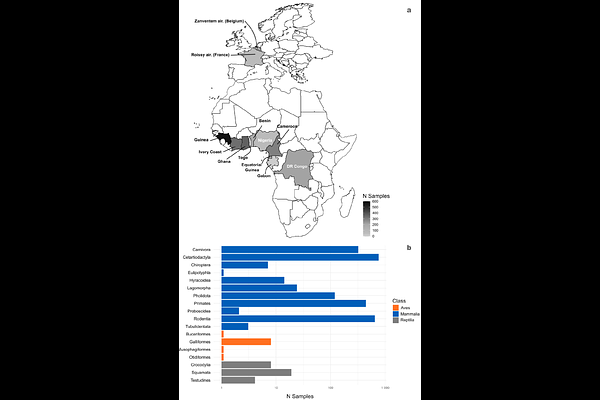Advancing global DNA-referencing of bushmeat in African tropical forests: a tool for identifying trade hotspots and dynamics in western and central Africa

Advancing global DNA-referencing of bushmeat in African tropical forests: a tool for identifying trade hotspots and dynamics in western and central Africa
Pires, D.; Gomes, C.; Groom, B.; Dufour, S.; Danquah, E.; Van Vliet, N.; Ayecaba, G. N.; Missoup, A. D.; Afiademanyo, K.; Djagoun, C. S.; Gonedele, S. B.; Chaber, A.-L.; Olayemi, A.; Antunes, A.; Gaubert, P.
AbstractThe bushmeat trade in Africa is a largely unregulated activity that drives the unsustainable exploitation of wild terrestrial vertebrates--an issue often coined the bushmeat crisis. We build on a four-gene mitochondrial DNA-typing approach to develop an unprecedented reference database framework for effectively tracing the bushmeat trade in tropical Africa. Our dataset comprises over 2,500 samples collected over a 13-yr period across 10 African countries and two European airports. Relying on an expert analytical pipeline and ~8,700 nucleotide sequences, we identified 96% of samples to the species-level. In contrast, we estimated that conventional two-gene approaches would have yielded 18-26% erroneous or inconclusive taxonomic assignments. DNA-typing refined > 50% of field identifications, with refinement reaching 92-95% for highly processed carcasses seized in Europe. Leveraging expanded taxonomic representation, we empirically refined the genetic species thresholds applied to bushmeat and provide a reproducible pipeline for using our expert reference database from NCBI. Overall, we identified 133 species--mostly mammals--with one-third listed as of conservation concern, and uncovered cryptic diversity evidence within several taxa. Our results also demonstrated the value of community ecology indexes for large-scale monitoring of the bushmeat trade. While national markets generally mirrored regional biodiversity patterns across tropical Africa, Benin emerged as a notable outlier and a key wildlife trade hotspot. We advocate for the integration of community ecology frameworks into surveillance efforts to guide more effective, regionally tailored mitigation strategies. Continued, standardized sampling is essential to broaden taxonomic coverage and enhance detection of cryptic biodiversity in genetic bushmeat monitoring.